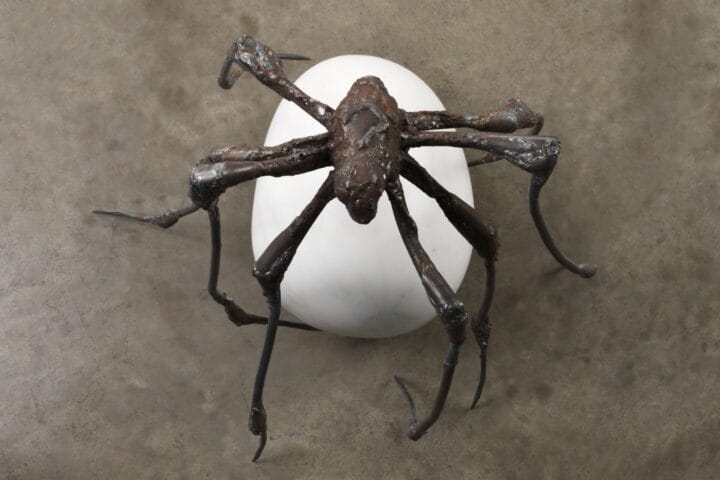Alexander Gray Associates, Germantown presents Harmony Hammond: Monotypes. This exhibition follows the evolution of Hammond’s monotypes, featuring a selection of works from three series that trace her deep engagement with process: the Bleeding Manuscripts made at the Vermont Studio Center in 1997; a series of “near-monochrome” works created at the Anderson Ranch in Colorado in 2008; and her recent body of Grommetypes (2011–ongoing).
Hammond’s works on paper represent an extension of her interest in post-minimal concerns with materials and process, simultaneously in conversation with her painting practice while pushing the boundaries of traditional printmaking. Whereas her paintings imbed fabrics and metal grommets in thick layers of pigment, her monotypes involve a slow build-up of thin layers of ink or paint on a printing plate that is then imprinted onto paper. Viewing the press itself as a collaborator, Hammond works in a “state of peripheral control,” or intentional unpredictability, allowing the pressure of the press to move the ink and activate the surface.
In the Bleeding Manuscripts, ink extends beyond the rectangular bounds of the printing plate, revealing subtle layers of colors and undertones. Seams that begin to vertically bifurcate the surfaces evoke open books or manuscripts with the text literally bleeding off the pages, obscured beyond recognition.
Working back into the residue of ink left on the plate after each pass of color, Hammond continued to push her process of layering with a series of near-monochrome monotypes she created at the Anderson Ranch in the mid-2000s. A horizontal bifurcation—created by printing with two plates simultaneously—opens up the pictorial space, transforming it into an abstract landscape of painterly marks and textured “accidents” left by the press.
In 2011, Hammond began working with master printer Marina Ancona at 10 Grand Press, introducing metal grommets into her monotypes to create her Grommetypes—a term coined by critic Lucy Lippard. Building up layers of wet-into-wet ink printed on pre-grommeted handmade paper, this new variable interrupts the printed surface, creating more “accidents” and imbuing the works with a sculptural quality. This ongoing body of work, produced both in continued collaboration with Ancona and on her own, culminates with Hammond’s newest Cross Grommetypes.
Hammond’s disruptive printmaking processes result in unique works that expand the potentialities of planographic monotypes. Though their textured surfaces often recall other materials like rusted or patinated metal, leather, or even sheaves of pure pigment—associations happily welcomed by the artist—replication has never been the goal of Hammond’s monotypes. To Hammond, “They are nothing but themselves: ink, and grommets, and paper.”
Harmony Hammond was the subject of a 2019 survey exhibition Harmony Hammond: Material Witness, Five Decades of Art presented by The Aldrich Contemporary Art Museum in Ridgefield, CT, which traveled to the Sarasota Museum of Art, FL in 2020. Other one-person exhibitions of her work include Harmony Hammond: Big Paintings 2002–2005, Center for Contemporary Arts, Santa Fe, NM (2005); Harmony Hammond: Monster Prints, SITE Santa Fe, NM (2002); and Harmony Hammond: Ten Years 1970–1980, Glen Hanson Gallery and W.A.R.M, Minneapolis, NM (1981), among others. Her work has also been included in many group exhibitions, including Women in Abstraction, Centre Pompidou, Paris, France (2021), traveled to Guggenheim Museo Bilbao, Spain (2021); Making Knowing: Craft in Art, 1950–2019, Whitney Museum of American Art, New York (2019); Queer Abstraction, Des Moines Art Center, IA (2019), traveled to Nerman Museum of Contemporary Art, Overland Park, KS (2019); Painting 2.0: Expression in the Information Age, Museum Brandhorst, Munich, Germany (2015), traveled to Museum Moderner Kunst Stiftung Ludwig, Vienna, Austria (2016); Wack!: Art and the Feminist Revolution, Museum of Contemporary Art, Los Angeles, CA (2007), traveled to National Museum of Women in the Arts, Washington, D.C. (2007); Vancouver Art Gallery, British Columbia (2008); and MoMA PS1, Long Island City, NY (2008); and High Times Hard Times: New York Painting 1967–1975, Weatherspoon Art Museum, University of North Carolina, Greensboro, NC (2006), traveled to Katzen Arts Center, American University Museum, Washington, D.C. (2006); National Academy Museum, New York (2007); Museo de Arte Contemporaneo Internacional Rufino Tamayo, Mexico City, Mexico (2007); Neue Galerie Graz, Austria (2007); and ZKM Center for Art and Media, Karlsruhe, Germany (2008); among others. Hammond’s work is in the permanent collections of Art Institute of Chicago, IL; Brooklyn Museum, NY; Metropolitan Museum of Art, New York; The Museum of Modern Art, New York; National Museum of Women in the Arts, Washington, D.C.; New Mexico Museum of Art, Santa Fe; Phoenix Art Museum, AZ; Walker Art Center, Minneapolis, MN; and Whitney Museum of American Art, New York, among others. She is the recipient of many awards and fellowships, including the Anonymous Was A Woman Award (2014); the Lifetime Achievement Award, Women’s Caucus for Art (2014); the Distinguished Feminist Award, College Art Association (2013); The Pollock-Krasner Foundation Fellowship (2007,1989); Joan Mitchell Foundation Award (1998); Art Matters Award (1996); Adolph & Esther Gottlieb Foundation Fellowship (1995); John Simon Guggenheim Memorial Foundation Fellowship (1991); and the National Endowment for the Arts Fellowship (1983), among others. Hammond’s book Wrappings: Essays on Feminism, Art and the Martial Arts (1984) is a foundational publication on 1970s feminist art. Her groundbreaking book Lesbian Art in America: A Contemporary History (2000) received a Lambda Literary Award and remains the primary text on the subject.
More information on Harmony Hammond
More information on Harmony Hammond: Monotypes










